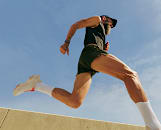
helivideo / iStock / Getty Images Plus via Getty Images
How to Tell If Your Abs Are ‘Coning’ or ‘Doming’ During Workouts
Plus, what to do if you spot abdominal doming during a workout or while performing everyday movements.
By Kathleen Felton•
What Is Abdominal Doming or Coning?
How to Tell If Your Abs Are Coning or Doming
Who Can Experience Abdominal Doming?
How to Fix Abdominal Doming
Are There Risks of Abdominal Doming?
The Takeaway
Imagine this: You’re in the middle of a sit-up, crunch, or plank when you look down and notice your abdominal muscles bulging outwards. Sounds familiar? You might be experiencing something called abdominal coning.
Discover more ways to reach your goals with Peloton
Also sometimes referred to as abdominal doming, this cone-shaped appearance on your belly can have a few possible causes, and it’s common to spot during core exercises. (On TikTok, many people express surprise that they’ve been coning during core workouts for years without realizing it.)
Luckily, abdominal doming usually isn’t a huge cause for concern, and there are steps you can take to prevent it from happening. Read on for more about why you might notice this symptom during exercise and how to correct it in the future.
What Is Abdominal Doming or Coning?
Abdominal coning and abdominal doming are usually used to describe the same thing: a cone-shaped appearance around your six-pack area. “This is a bulging down the middle of the abdominal wall,” explains Erin Weber, a pelvic floor physical therapist at Flow Physiotherapy.
The main tissue affected here is your linea alba, a thin tendon that runs down the middle of two long ab muscles called your rectus abdominis. Occasionally, the linea alba can get stretched out and slightly separated due to increased pressure on the abdominal walls. Because this tendon is so thin, “it requires more coordination to manage pressure,” Weber explains, such as by engaging your deep core muscles when you do a sit-up, for example. But when that coordination of pressure doesn’t happen as it should, the linea alba can bulge out and create visible coning or doming along your midline.

Peloton App
Access thousands of classes with no equipment needed.
How to Tell If Your Abs Are Coning or Doming
It can be tricky to spot ab coning or doming if your case isn’t too severe, notes Sherry Ross, MD, OB/GYN and author of She-ology, but many people see symptoms for the first time while exercising.
Abdominal doming can have varying degrees of roundness; for some people, it might look pointier and more-cone shaped, while it may appear more dome-like for others. (This also helps explain the different terms.)
The bulge will appear in the middle of your abdomen as opposed to on either side, and it shouldn’t feel painful, Weber says. (If you do feel pain, you’ll want to let your doctor know.)
You may notice abdominal doming during movements that require you to contract your ab muscles, such as:
Planks
Leg lifts
Crunches
Sit-ups
Pull-ups
Rowing
Overhead pressing movements
Lifting heavy weights
Leaning back in a chair
Pulling yourself up from a lying-down position
Who Can Experience Abdominal Doming?
“People who experience coning and doming are those who have conditions that consistently increase abdominal pressure,” Dr. Ross says. There are a few different things that can cause that boosted pressure, but one of the most common and well-known is a condition called diastasis recti.
“[Diastasis recti] usually comes on during pregnancy,” Weber says. “It’s a normal adaptation when the tissue needs to stretch, and that middle tendon gets thinner.” As this tendon stretches to accommodate a growing baby, a gap can appear in the rectus abdominis muscles; a separation 2 centimeters or greater is officially considered diastasis recti.
This condition is common: Some research suggests diastasis recti affects as many as 60 percent of women in the postpartum period. The gap often heals on its own, but you can also work to close the separation with the help of a physical therapist and home exercises.
But pregnancy isn’t the only way you can develop abdominal doming. Weber points out that it can also develop if you’ve been doing activities that create a significant “bearing down” effect on the abdominal wall. That might happen, for example, if you’ve been coughing a lot lately or doing certain core exercises (such as the ones listed above) incorrectly.
“[Abdominal coning or doming] can happen from using an incorrect abdominal engagement strategy,” Weber explains. If you notice doming and don’t have diastasis recti, that indicates your six-pack muscles (the rectus abdominis) are dominating over your deep core muscles. Doming might also occur because you’re pushing out and not contracting your core muscles tightly while you exercise your abs. This might happen if you’re holding your breath rather than timing your inhales and exhales to your movements, she adds. (More on that later.)
Having certain kinds of pulmonary conditions, a genetic disposition, or being obese can also up your risk of abdominal doming. As a result, men can “absolutely” experience abdominal coning too, Weber says.
How to Fix Abdominal Doming
How you address abdominal doming or coning will depend on why you’re experiencing it in the first place.
If you have doming due to diastatis recti, you should approach core exercises with caution and skip movements like sit-ups or crunches while you heal. Rather, experts from the Cleveland Clinic and the Hospital for Special Surgery recommend performing gradual and gentle movements that contract and tighten your abdominal muscles. It’s always smart to work with a physical therapist who can create a custom treatment plan that allows you to progress safely and appropriately.
But if you notice abdominal doming and don’t have diastasis recti, “it just means you need to focus on getting your deep core (the transverse abdominis) to fire by pulling the navel in and using an exhale,” Weber says. “If you can correct it, then the doming with crunches and planks should subside.”
But how exactly do you activate those deep core muscles during exercise? If, say, you’re doing a sit-up and notice that your abdomen is coning, Weber recommends working to minimize it by doing the following:
First, check your form—if you’re in a plank position, for example, make sure you’re bracing your core and glutes to maintain a straight line from heels to hips to head.
Before you start your movement, exhale to “turn on” your deepest abdominal muscles.
As you exhale, focus on drawing in your naval towards your back and imagine that you’re “sewing” your rib cage down toward your midline.
Paying close attention to your breath, use your inhales and exhales to further activate those deep core muscles and move with control. Be careful not to hold your breath—remember, this can actually cause coning.
Are There Risks of Abdominal Doming?
The good news is that while abdominal doming may indicate you’ve been performing core exercises incorrectly or have diastasis recti, for example, the bulge you’re seeing isn’t going to hurt you.
“Doming is a sign of you not coordinating your abdominals correctly,” Weber says. “It doesn’t mean you’re creating long-term damage and should hold off on exercising.”
It does mean you may need to improve the way you’re coordinating those deep abdominal muscles, though, she says. If you see it happening and aren’t able to improve the coning by properly activating your core with the steps above, it may be time to see a physical therapist who specializes in diastasis recti work.
Definitely let your healthcare provider know, too, if you notice any of the below more serious symptoms:
The bulge seems to be getting worse, or the pressure is feeling greater
It’s painful
There’s a specific bulge in one spot that also feels painful (this could be a hernia)
You’re continuously working on deep core exercises but the coning isn’t improving
The Takeaway
Abdominal doming or coning refers to a visible bulge that protrudes from the middle of your abdomen. If you have abdominal doming, you’re likely to notice it while exercising your core—say, while doing sit-ups, crunches, or planks. Noticing this symptom is a sign that you need to work on your deep core muscles, experts say, and could also mean you have a condition such as diastasis recti. If you spot abdominal doming, work to draw your naval in tightly to your spine and pay close attention to your breath, using your inhale and exhales to fire up your deepest core muscles. If that doesn’t fix your coning, it’s never a bad idea to see a physical therapist who can help.
Related Articles
This content is for informational and educational purposes only and does not constitute individualized advice. It is not intended to replace professional medical evaluation, diagnosis, or treatment. Seek the advice of your physician for questions you may have regarding your health or a medical condition. If you are having a medical emergency, call your physician or 911 immediately.
Get our latest health stories straight to your inbox
Enter your email to get articles, expert-backed tips, and updates from Peloton sent to your inbox.
By providing your email address, you agree to receive marketing communications from Peloton.
For more about how we use your information, see our Privacy Policy.









